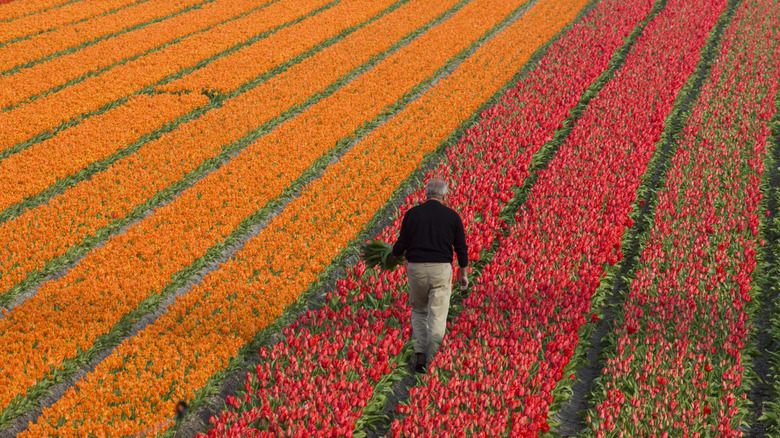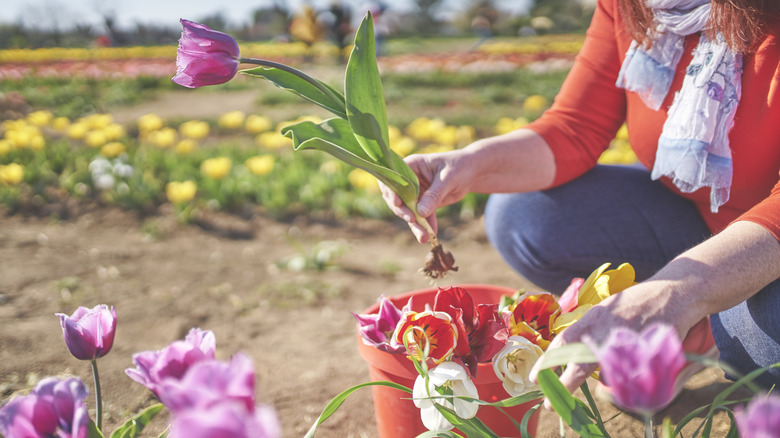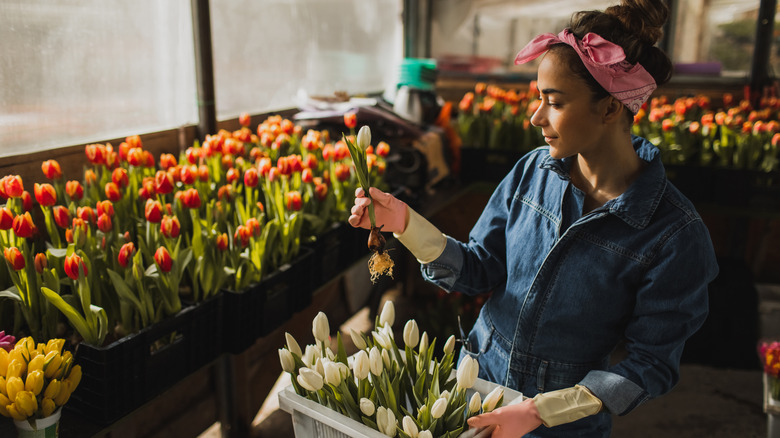Why Flower Farmers Might Want To Think Twice Before Growing Tulips
The delicate cup shape and vibrant colors of tulips are iconic spring flowers for Easter arrangements and Mother's Day bouquets, but are they worth including in a flower farmer's business plan? While there are mistakes everyone makes when growing tulips in the garden, every stem is either a potential sale or a loss for a flower farmer. And since we need all of the space we can get to maximize profits, we can't leave the bulbs in the ground for the rest of the year to gather energy and bloom again. With only one bloom per bulb each year, new flower farmers should consider a few points about space and disease before committing to a field of tulips.
As spring flowers, tulips are naturally at risk for a devastating disease. Botrytis is a mold that causes up to $100 billion in crop losses worldwide every year. The spores of this mold need a film of water for 8 to 12 hours. Cloudy days keep condensation from evaporating off of the plant, allowing the spores to grow. It can also start inside the cooler if the tulips are damp. Once one flower has it, botrytis will spread rapidly to every other flower in that bucket or arrangement, so the loss can be heartbreaking for farmers. On the flower farm I work for, we lost nearly half of our tulip inventory to botrytis this year. Keeping tulips dry is very important because of this.
Growing tulips takes up a lot of space
Growing tulips takes up a lot of space, especially when compared to most other flowers that are perfect for a cut flower garden. Since each bulb is used only once a season before being replaced with another plant, every square inch of space used has to be considered when planning and pricing tulips. As farmers, we tend to sell to florists, who then sell arrangements and bouquets to their clients. So we harvest before the blooms open and then store them in a cooler to prolong the bloom time. The minimum indoor space required to sell tulips is a cooler large enough to store either crates of them with their bulbs still attached or buckets of cut stems. Without a cooler, the tulips will open too quickly and go to waste.
Also, a greenhouse is handy but a limiting factor. In our greenhouse, we lay out rows of crates filled with fluffy potting soil while it's still freezing outside. They are ready early in the spring and are much easier to harvest by pulling up the whole bulb from the less compacted soil. With the bulb still attached, they don't need to be stored with water, and they can last about a month in the cooler! However, the size of the greenhouse limits the number of crates you can lay out. We filled around 120 crates with 76 to 96 bulbs, but we also had to utilize field space to meet demand.
The pros of growing tulips on the farm
While space limitations and disease concerns are worth keeping in mind, they don't have to scare flower farmers away from one of the most popular cut flowers around. Tulips are beloved for their bright colors that pop up right as the cloudy and cold weather starts easing away. They are one of the earliest flowers you can grow — especially with the help of a greenhouse — just in time for the major spring holidays that drive customers to buy flowers: Easter and Mother's Day. From the bright reds, yellows, and oranges to the softer pinks and purples, there's something for almost every arrangement style. The best kind of tulips for beginner gardeners to plant can also work for beginner farmers looking to incorporate this festive flower.
The only reason to pause and consider whether you should sell tulips on your flower farm is if you don't have the space or manpower to do it in a way that is profitable. Greenhouses are very expensive, but to plant a field, you will need to put thousands of bulbs in the ground, usually with machinery. You will have loss issues, and we sell tulips to florists in bunches of 10. You should consider how many tulips you can grow in your space and how many you will need to sell in order for them to be worth all of the time and energy.


